WARNING: GRAPHIC CONTENT – After she stopped using topical steroid creams, Harriet Hammond says her skin was literally ‘falling off.’
A charity worker who stopped using steroid creams to treat eczema told how her withdrawal symptoms – including livid rashes and painful, oozing blisters – were so severe she could not work for four months and is unable to be intimate with her boyfriend.
Plagued by the dry and itchy skin condition eczema since childhood, over the years, Harriet Hammond, 28, who works for the Stroke Association, saw various GPs and dermatologists – who often prescribed topical steroid creams to ease her condition.
Realising in her teens that her skin had built up a tolerance to the remedies, if she stopped using them for just a week, she said her condition would return with a vengeance.
Harriet, who lives in Aylesbury, Buckinghamshire, with her boyfriend, Tom Barratt 30, a senior technician at a fire research company, said: “My dry skin was a sensitive subject for me. I remember how embarrassed I would feel at social events.
“In 2015 I went to friend’s hen do holiday in Wales and we had to wear wetsuits as we were going water rafting.
“I knew the tight suit wouldn’t agree with my skin, and to make it even worse my bottle of lotion fell out of my bag and smashed on the floor before I had even got changed.”
She continued: “I felt humiliated and wanted to hide because everyone heard the bottle smash and must have wondered why I needed to have so much cream with me. My skin wasn’t horrendous by this point, but it was enough to notice there was an issue.”
Too self-conscious to wear clothes that would show her eczema, which was all over her body, she covered up on nights out and avoided wearing swimwear even on holiday – writing about the misery of having severe eczema in her old diaries.
She recalled: “I kept a diary from the age of 25 until around 28 and it’s filled with references to my eczema.”
She added: “It says things like, ‘my skin is on fire’ and, ‘I was awake all-night scratching’ – I’d explain to doctors how it even hurt when I showered, but the only real treatment seemed to be steroid creams.
“I was told to use more and stronger creams when they stopped working, even though experts online said they shouldn’t be used continuously, but that’s what my GP advised.
“After a while they weren’t much help and, whenever I finished using them, my skin would be 10 times worse than before.”
Eventually, searching social media, aged 27, she found communities where she could share her woes with people who had suffered similar experiences – which led her to discover topical steroid withdrawal.
“I realised I wasn’t alone. Beforehand, I had blamed myself for the state of my skin and looked at my diet and lifestyle to see what I could change,” said Harriet.
“But the one thing I had in common with all the people I was speaking to online was that we had all been using steroid creams.”
She continued: “A lot of people suggested I should stop depending on them if I wanted to get better.
“I knew topical steroid creams could have side effects, too, like thinning the skin, so on January 31 2018 I decided to ditch them completely.”
Rather than just going ‘cold turkey,’ Harriet tried hypnotherapy and acupuncture, hoping they might help ease her eczema, but to no avail.
Without the steroid creams, by May 2018, her skin had become so covered in rashes and oozing blisters that she was signed off work and had to move out from the home she shared with her boyfriend and in with her retired parents, Tessa, 63, and dad Gareth, 64, for four months.
Unable to move much or wash herself properly, because of the excruciating pain her skin was in, even while performing simple tasks like making a cup of tea, she needed their full-time care.
While doctors advised she go back to using steroid cream and even suggested she take an immunosuppressant drug – used to prevent or inhibit the activity of the immune system – Harriet ignored their advice, fearful of becoming dependent on a new medicine.
“There were rashes all over my body and my face was red and incredibly swollen,” recalled Harriet.
“I was signed off work by a doctor because my skin appeared to be literally falling off. It seemed like she just wanted to dismiss me. She didn’t diagnose it as topical steroid withdrawal. She just sent me on my way and didn’t seem to acknowledge what was truly happening.
“I couldn’t walk or move much at all without being in pain. I lost over two stone in weight, but I have no idea why as I was still eating, and lost a third of my hair as my dry and scabby scalp made it fall out.”
Recalling how she looked like she was wearing a “red body suit,” Harriet told how her mum would help her to wash with a flannel and to eat, drink and dress, as the movement required when performing these tasks alone made her skin split.
Waking to a bed full of dead skin, while the surface of her body was oozing with a clear fluid, she said her mental health began to deteriorate in line with her worsening physical state.
Sleeping for a maximum of three hours a night, because of the discomfort, Harriet’s mum took her to the doctor in November 2018, who prescribed her pills for anxiety, but she claims did not help to treat her skin.
Luckily, she was able to move back in with her boyfriend in September 2018 and begin working again part-time the same month after her skin slowly improved – although she still has flaking skin and red rashes.
She said: “I feel better now that I’m not housebound, but I’m still suffering.
“My work distracts me but, once I get home, the reality that it hasn’t gone away hits me again and I feel the urge to scratch or cry.”
Harriet now copes with her condition without steroid cream by refusing to moisturise altogether and showering and baths – which she says makes her itchier.
Her current choices have been based on advice from other online users who say they have suffered from topical steroid withdrawal – but, like Harriet, have not been formally diagnosed.
Now determined to manage without any creams, in the hope that her skin will heal itself, Harriet’s eczema is still severe – even preventing from being intimate with her boyfriend.
She said: “We can’t be intimate at all because it’s just too uncomfortable and painful to move that much and be so close to someone else’s skin. It’s been this way for a year – ever since I ditched steroids.”
She continued: “We’re affectionate and he does a lot for me, like washing my hair and cooking for me because getting my hands wet makes them awfully itchy and preparing food can bring my skin out in more rashes.
“I don’t want him to become my carer, so I try to make my own dinners sometimes – which ends up being a celebration for the achievement.
“We hoped to move away last summer to Hertfordshire and get new jobs because we wanted to make a fresh start for ourselves, but my condition has put us on hold.
“I hope that with time I will improve, and eventually we can live how we always dreamed.”
Her boyfriend Tom remains horrified by the change in the woman he loves.
He said: “She’s a shadow of her original self. I’ve never seen anyone change so much through unbearable pain.
“She’s amazing for going back to work and helping others through that, but I know she’s still suffering when she comes back home and tries to get on with her personal life.
“I planned on proposing last year but the time wasn’t right – I hope that, with time and healing, eventually things will get better and we will be able to get back to normal.”
Andrew Proctor, Chief Executive of the National Eczema Society, commented on the condition: “Topical steroids are the most common form of first-line treatment for inflammation in eczema. These are typically used for short treatment bursts during flare-ups and come in different strengths or potencies.
“Topical steroids of different potencies will usually be prescribed for different areas of the body: less potent ones for delicate skin and more potent ones for thicker skin.
“Research and clinical evidence suggest that topical steroid dependency/addiction is a distinct adverse effect of the use of topical steroids, but is extremely rare.
“It usually occurs when potent or very potent topical steroids have been used in the wrong place, such as on the delicate skin of the face, on a daily basis for many months. To avoid the risk of dependency, potent and very potent topical steroids are best used in bursts rather than continuously.”
AUGUSTA, Ga. (AP) — Camilo Villegas wasn't just trying to refine his golf swing as he prepared to play in the Masters for the first time in nine years.
He was constantly checking the fine print on the ingredients in sunscreen. It reached a point a few weeks ago when the 42-year-old Colombian was trying three brands — one for his face, another for his arms, a third for his legs during practice rounds when PGA Tour players can wear shorts.
Nothing is left to chance.
“The first one I realized was more of a cosmetic. It didn't really work as strong as I wanted,” Villegas said. “I'm trying a Korean brand now, and that has worked pretty good.”
Skin cancer has his attention — along with many of his fellow golfers.
There seems to be a renewed emphasis on sun protection. Golfers are more exposed to the sun for longer periods of time than players in any other sport. The weekday rounds last five hours. Throw in an hour of practice before the round, sometimes after, and it adds up quickly.
“The amount of time we spend in the sun, you've got to protect yourself,” Villegas said. “The sun is burning you.”
No need telling Stewart Cink. He was walking off the practice range at Innisbrook Resort in Palm Harbor, Florida, last month when he was asked why sun protection was important to him.
“Well, as someone whose maternal grandmother passed away from melanoma, and someone who's out in the sun a whole lot and someone who already had a big chunk of stuff cut off the side of my face,” he said, pausing to smile. “It very important, not to mention what my wife is going through with her (breast cancer) treatment. It would be dumb not to.”
The American Academy of Dermatology estimates one in five Americans will develop skin cancer. The non-melanoma variety, such as basal cell carcinoma and squamous cell carcinoma, affects 3 million Americans a year.
Sunscreen is just one form of protection.
Stephanie Kyriacou of Australia has always been conscious about the effects of the sun, but a turning point during her amateur days was meeting a woman at home Down Under who invited her to a factory in Queensland.
That was her introduction to Australia-based “SParms,” which makes sun protection sleeves that have become enormously popular on the LPGA Tour.
The sleeves are made of high-tech fabric with an ultraviolet protection factor (UPF) of at least 50, meaning it blocks 98% of the sun's ray. The sleeves can go up the arm and wrap around the shoulder blade.
“Like a lot of girls out here, I'm aware of my skin,” Kyriacou said. “Sunscreen on my face and SParms on my arms. And I like to wear pants unless it's boiling hot.”
Now there are some 60 players at any given tournament wearing sun sleeves.
Kyriacou estimates she's in the sun for at least seven or eight hours a day, and the 23-year-old Aussie has been playing since she was 4.
That's typical of most tour players. They have spent practically their entire lives in the sun, facing the ultraviolet rays that can cause so much damage.
Exposure to the sun’s ultraviolet light raises the risk of skin cancer, the most common and one of the most preventable types of cancer. The American Academy of Dermatology recommends using a sunscreen with a sun protection factor (SPF) of 30 or higher and one that is “broad spectrum,” meaning it protects against both UVA and UVB rays.
“I don't think I wore sunscreen ever,” Cink said. “You know, we use to wear suntan lotion or oil that would intensify the sun so you would get tan. I don't think I wore anything protective at least until I got on tour.”
It wasn't until he was 45 that Cink fully understood the danger. He had a basal cell carcinoma removed from the side of his nose in 2018. And now it's not just any sunscreen he uses.
“I am not a big fan of chemical sunscreen,” he said, referring to the more common brands. “I like the physical barriers, the zinc oxide and titanium dioxide. I look for something that has a high concentration of those two. You can find them if you search.”
Villegas found it on an app called Yuka, which deciphers product labels and analyzes the impact of food and cosmetics. That includes sunscreen.
“It's not perfect. You've got to do some analysis,” Villegas said. “But it gives you options. It's not like it takes you to a website to purchase something — that would make me skeptical. You compare products yourself and do the analysis.”
Skin cancer doesn't discriminate, so golfers of color also are seeking protection.
Xander Schauffele has darker skin, the son of a Taiwanese-born mother and a European father (French and German). He also uses the Yuka app and lately has been going with a product he calls Mr. Seaweed.
“It has less toxic stuff, I've been told by an app,” he said. “Sprays are bad. Cream is the best thing. I look up all that stuff.”
Justin Thomas, a two-time PGA champion whose father and grandfather were club professionals, said he has always used sunscreen, usually whatever is handy. Now he pays closer attention, and for good reason.
He said his legs and neck used to get hit pretty hard by the sun when he was practicing for long hours. He previously had five small moles removed as a teenager. But a tiny one on the back of his left leg concerned him in 2019 because of the odd color.
It turned out to be early stages of melanoma — the most dangerous form of skin cancer but curable if caught early — and he had surgery in which doctors cut down to the fat to make sure they got it all. The surgery left a scar across the back of his calf.
“I was 26 and my doctors are telling me I was months away from being a patient in the hospital,” Thomas said.
He wore sunscreen before. Now he is reading labels, paying particular attention to SPF and getting out the message that “you need to wear sunscreen and you need to get checked.”
AP Medical Writer Carla K. Johnson contributed to this report.
AP golf: https://apnews.com/hub/golf

Camilo Villegas, of Colombia, hits on the practice range during a practice round in preparation for the Masters golf tournament at Augusta National Golf Club Monday, April 8, 2024, in Augusta, Ga. (AP Photo/Matt Slocum)

Camilo Villegas, of Colombia, catches a golf ball on the practice range during a practice round in preparation for the Masters golf tournament at Augusta National Golf Club Monday, April 8, 2024, in Augusta, Ga. (AP Photo/Matt Slocum)
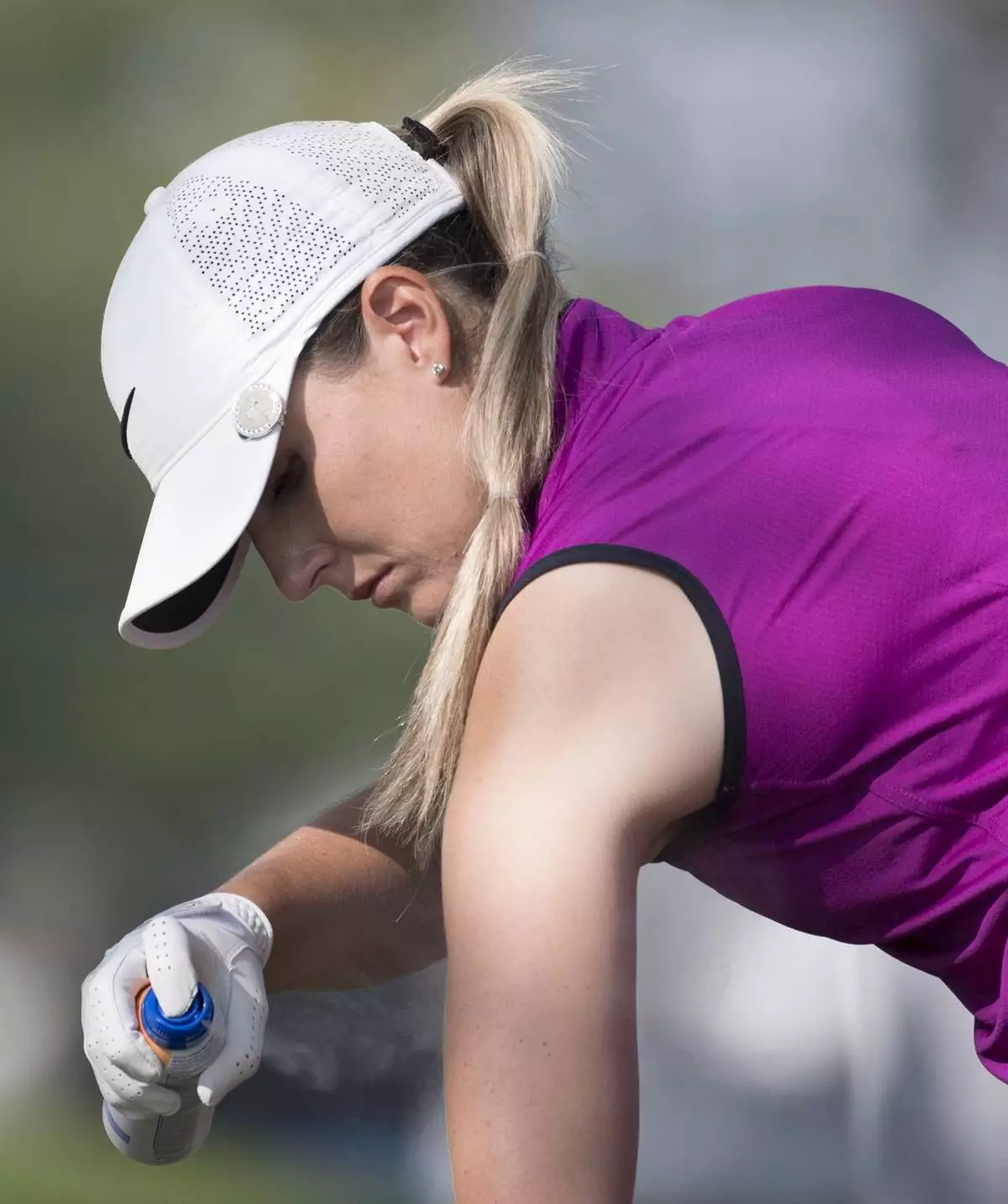
FILE - Megan Osland, of Canada, sprays on sunscreen during the first round of the Women's Canadian Open golf tournament in Regina, Saskatchewan, Thursday, Aug., 23, 2018. Golfers are in the sun as much if not more than players in other sport. It can be as many as eight hours a day. And there is renewed emphasis on protecting their skin. (Jonathan Hayward/The Canadian Press via AP, File)
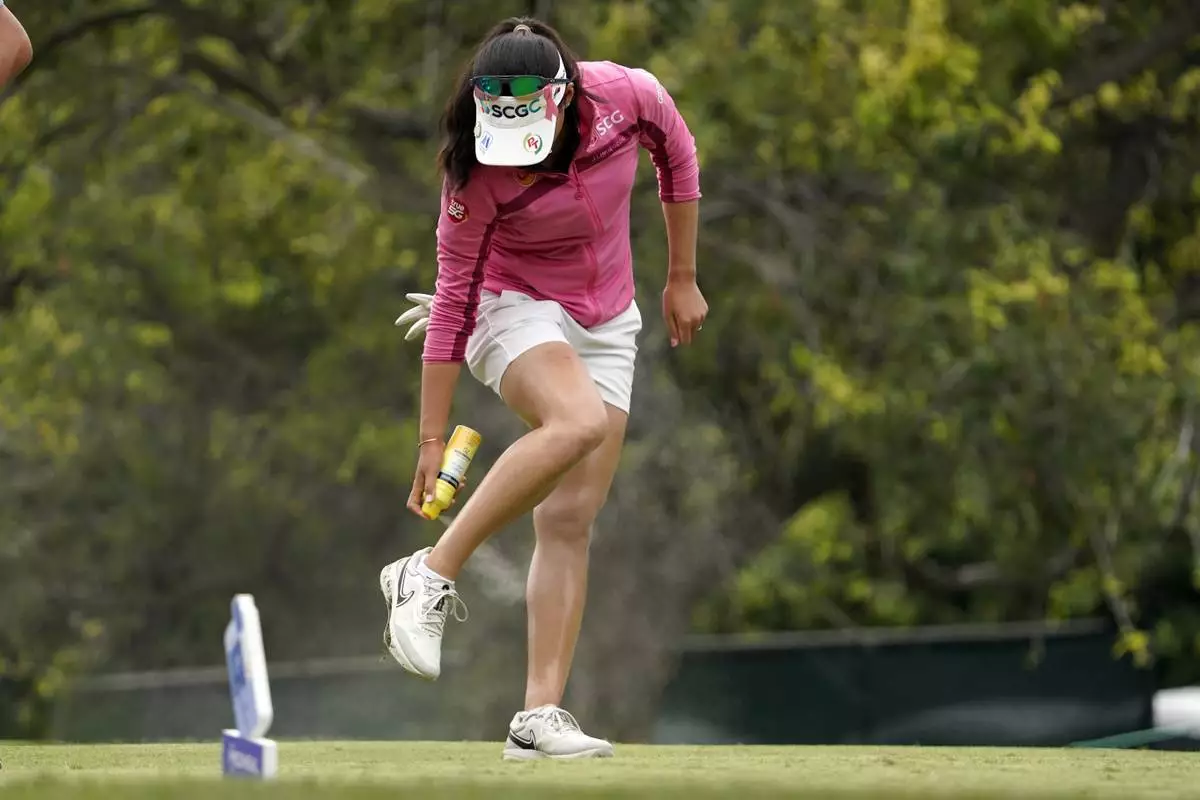
FILE - Atthaya Thitkul, of Thailand, sprays her legs with sunscreen on the third hole during the first round of the MEDIHEAL Championship golf tournament Thursday, Oct. 6, 2022, in Somis, Calif. Exposure to the sun’s ultraviolet light raises the risk of skin cancer, the most common and one of the most preventable types of cancer. (AP Photo/Mark J. Terrill, File)
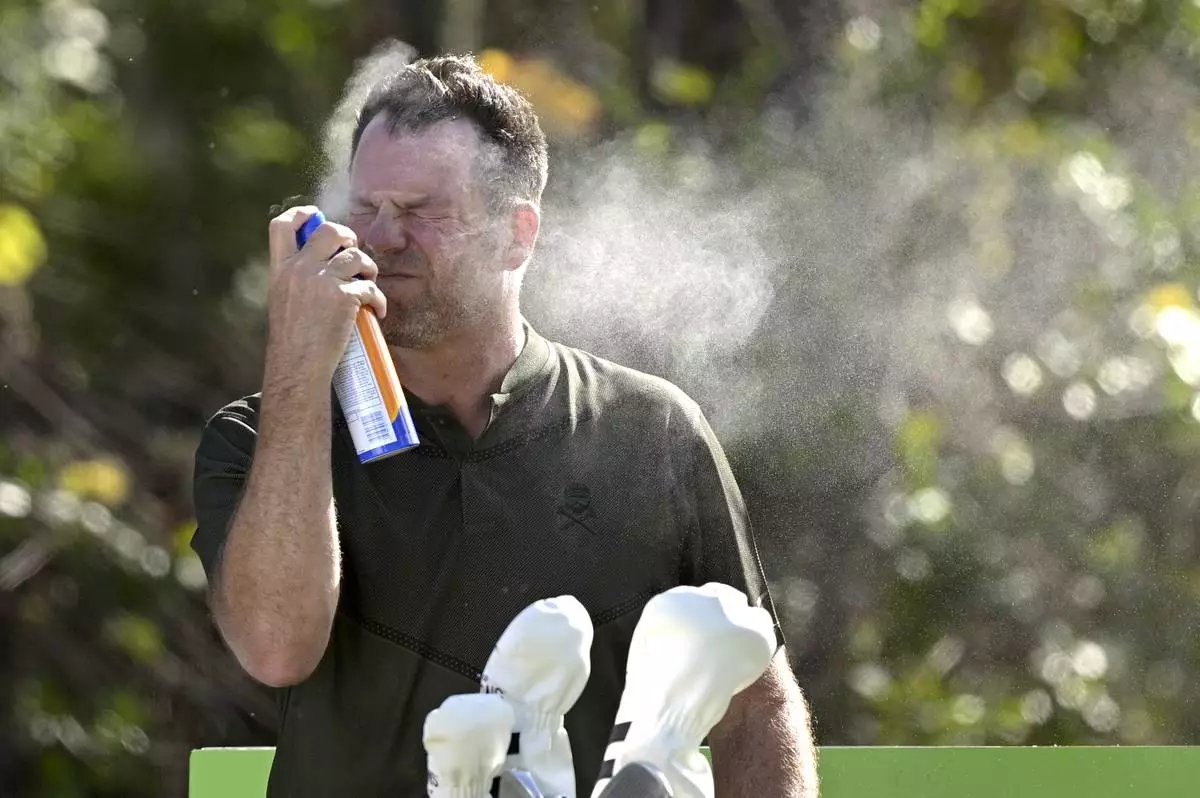
FILE - Mike Flaskey, CEO of Diamond Resorts International, sprays himself with sunscreen before hitting his tee shot on the second hole during the final round of the Tournament of Champions LPGA golf tournament, Sunday, Jan. 24, 2021, in Lake Buena Vista, Fla. (AP Photo/Phelan M. Ebenhack, File)
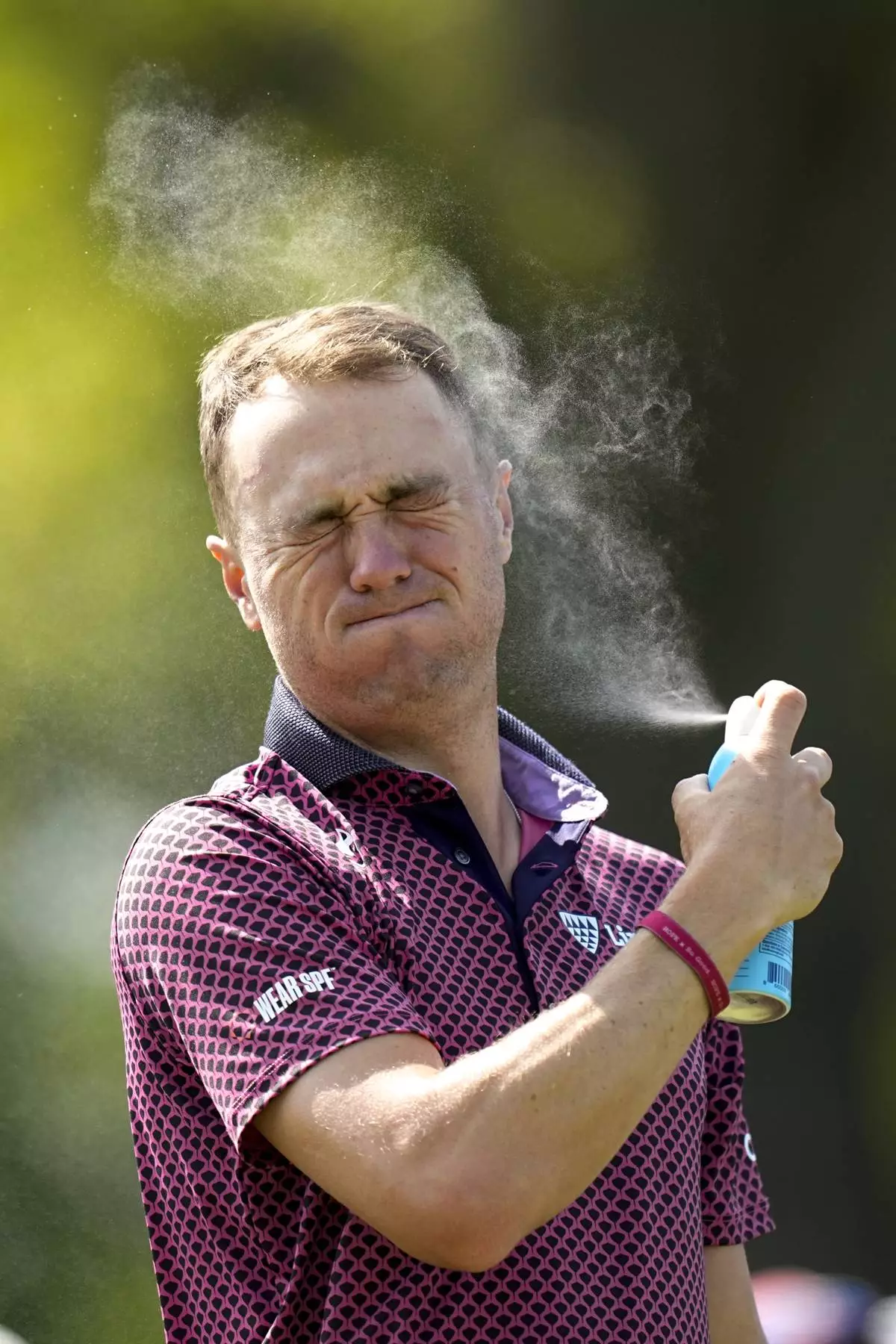
FILE - Justin Thomas applies sunscreen on the 11th hole during the first round of the PGA Championship golf tournament at Oak Hill Country Club on Thursday, May 18, 2023, in Pittsford, N.Y. Thomas, a two-time PGA champion whose father and grandfather were club professionals, said he has always used sunscreen, usually whatever is handy. Now he pays closer attention, and for good reason.(AP Photo/Eric Gay, File)

FILE - Stephanie Kyriacou, of Australia, tees off on the 13th hole during the first round of the ShopRite LPGA Classic golf tournament, Friday, June 10, 2022, in Galloway, N.J. Kyriacou has always been conscious about the effects of the sun. (AP Photo/Matt Rourke)

FILE - Jordan Spieth applies sunscreen during the first round of the SMBC Singapore Open golf tournament at the Sentosa Golf Club's Serapong Course Thursday, Jan. 28, 2016, in Singapore. Golfers are in the sun as much if not more than players in other sport. It can be as many as eight hours a day. And there is renewed emphasis on protecting their skin. (AP Photo/Wong Maye-E, File)
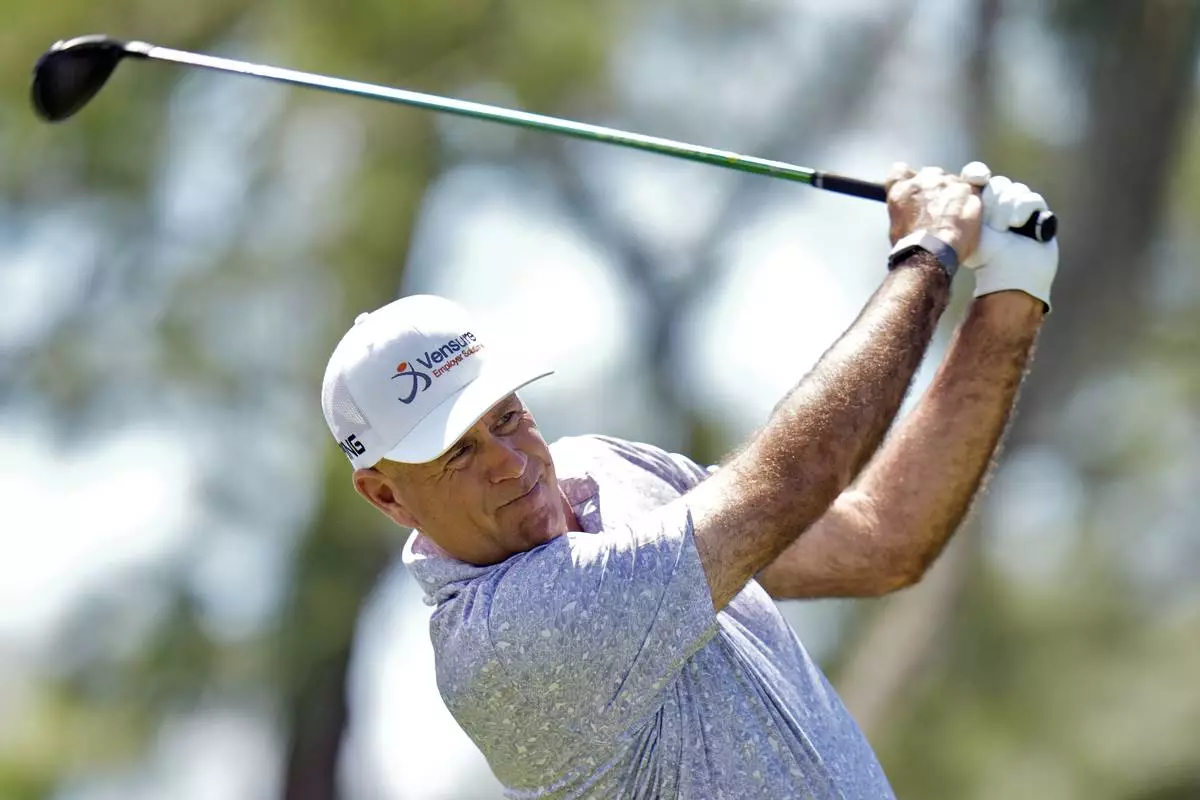
Stewart Cink tees off on the sixth hole during the third round of the Valspar Championship golf tournament Saturday, March 23, 2024, at Innisbrook in Palm Harbor, Fla. Golfers are in the sun as much if not more than players in other sport. It can be as many as eight hours a day. And there is renewed emphasis on protecting their skin. (AP Photo/Chris O'Meara)

Camilo Villegas tees off on the 11th hole during the first round of the Valspar Championship golf tournament Thursday, March 21, 2024, at Innisbrook in Palm Harbor, Fla. Golfers are in the sun as much if not more than players in other sport. It can be as many as eight hours a day. And there is renewed emphasis on protecting their skin. (AP Photo/Chris O'Meara)













